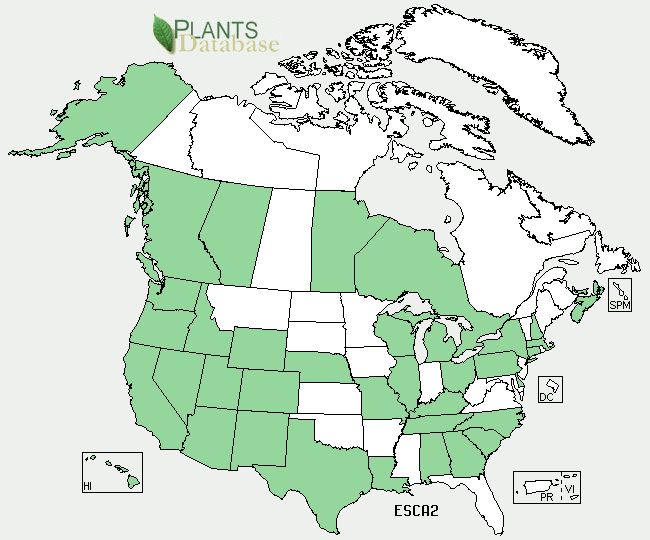Habitat
Eschscholzia californica is found in many geographic locations and diverse habitats throughout the United States, as well as in a handful of other countries. It is native to the United States but has been naturalized in other countries, including Australia, Chile, and New Zealand (Becker et al. 2005). In the United States, E. californica can be found in many locations, but mainly on the west coast and in the southern regions of the west coast (Smith 2010). Some regions that E. californica are native to include the Channel Islands, the Great Basin, and some parts of the Sonoran Desert (Smith 2010). The Channel Islands, which are part of California, consist of Anacapa, Santa Barbara, Santa Cruz, Santa Miguel, and Santa Rosa (Russell 2013). Not only are the poppies found in California, but they are also found in Nevada’s Great Basin and parts of the Sonoran Desert, including Arizona and Mexico (NPS 2013, ASDM 2013).
Photo courtesy of U.S. Department of Agriculture.
With this vast array of geographic locations, the habitat that is home to the California poppy becomes just as diverse. E. californica can grow at sea level up through roughly 6,500 feet, from dunes to hillsides, and from alluvial fans to river terraces (Cook 1962). An alluvial fan results from gravel or sand deposits being carried by flowing water to flat plains where the triangle-shaped fan forms (National Geographic 2013). E. californica can be further differentiated into E. californica ssp. mexicana and E. californica ssp. californica, with each being found in different habitats from one another.
Eschscholzia californica ssp. mexicana and Eschscholzia californica ssp. californica, are found in different locations and habitats (Smith 2010). E. californica ssp. californica, can further be differentiated into three variants (Smith 2010). These variants are commonly found in many areas of California as well as scattered throughout other coastal states, but E. californica isn't just restricted to California (Smith 2010). It is also found throughout the West Coast, including Washington state down to California, as well as Nevada (Clark 2000). With regard to habitat, E. californica ssp. californica can be found in dunes, valleys, arid plains, redwood forests, and in desert regions of the northern portion of Baja California (Clark 1978).
Photo courtesy of U.S. Department of Agriculture.
E. californica ssp. mexicana is found in California, Arizona, Utah, and Texas, including two mountain ranges, Organ Mountains and Franklin Mountains (Clark 1978). The locations above are part of the Sonoran Desert; therefore illustrating that E. californica ssp. mexicana grows mainly in desert conditions (Clark 1978). Seeing that this subspecies grows primarily in desert conditions, it has adapted to increased ground water depth, extreme temperature variations and durations, and low rainfall conditions (Smith 2010).
Since there are a lot of various geographic locations and diverse habitats of E. californica, there are many other organisms that live in the same locations and habitats. Some other plants that co-exist with the E. californica ssp. californica are oak savanna, fringe pods, lupines, and yarrow (Smith 2010). For E. californica ssp. mexicana, organisms such as clarkia, larkspur, Mariposa lily, and lupines co-exist with them (Smith 2010). With the vast array of locations and habitats, E. californica can tolerate various temperatures, precipitation levels, soil chemistries and soil textures (Smith 2010). These numerous conditions create an environment for many other organisms to co-exist with E. californica.


